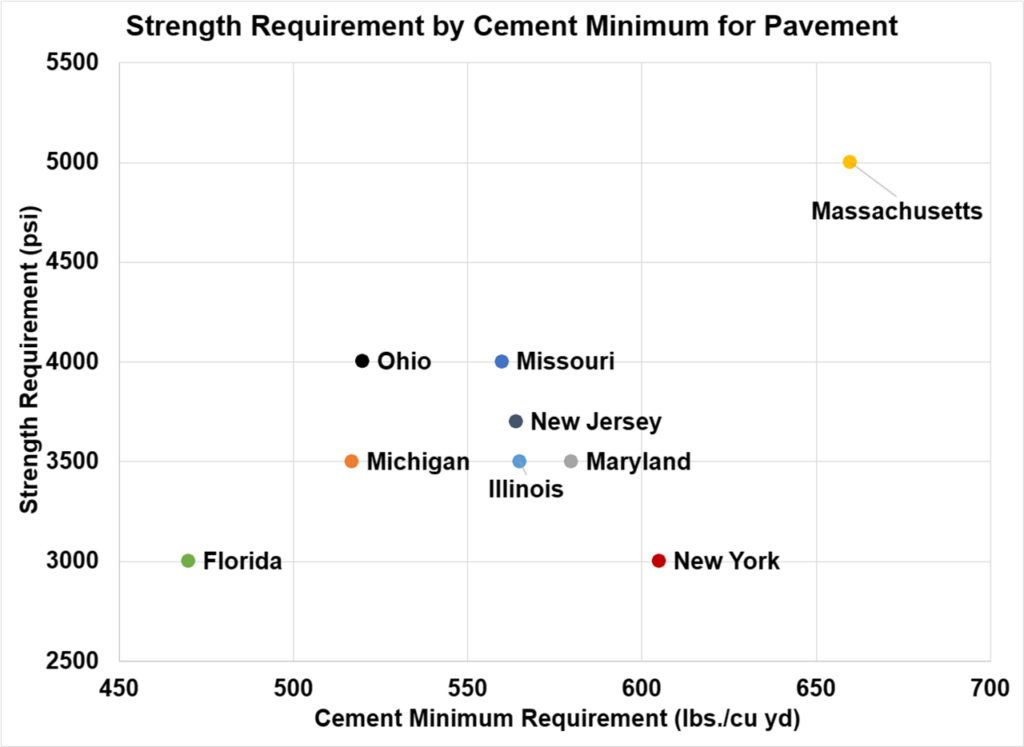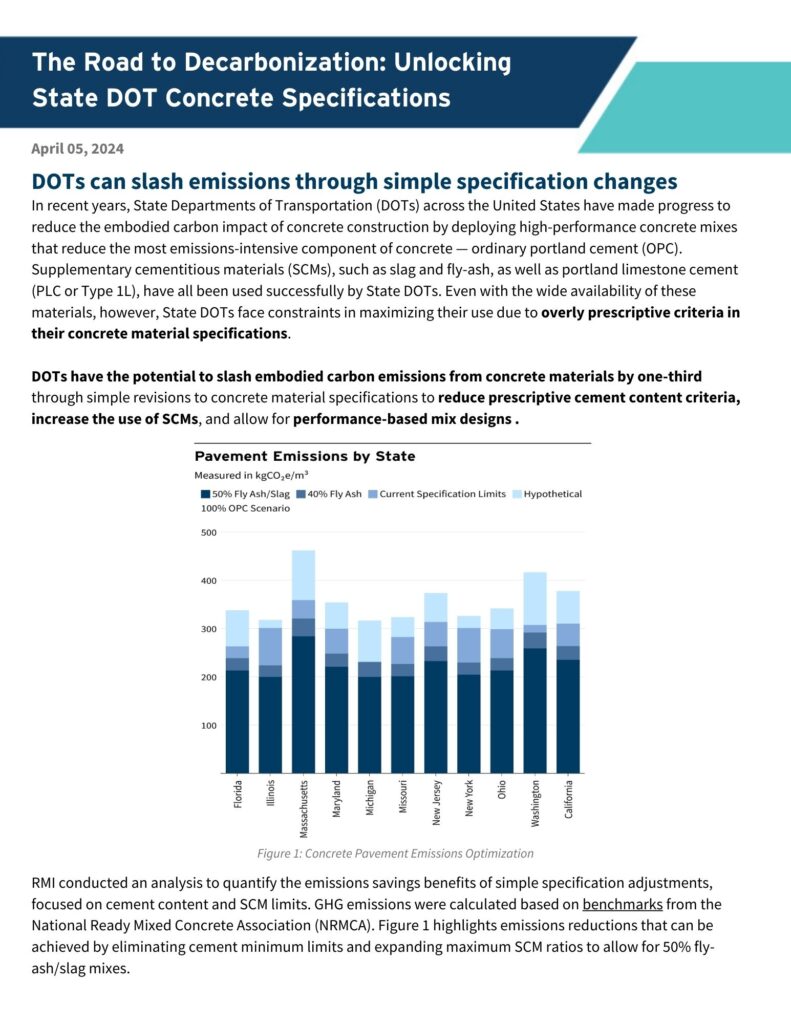
The Road to Decarbonization: Unlocking State DOT Concrete Specifications
Introduction
In recent years, state Departments of Transportation (DOTs) across the United States have made progress to reduce the embodied carbon impact of concrete construction by deploying high-performance concrete mixes that reduce the most emissions-intensive component of concrete — ordinary portland cement (OPC). Supplementary cementitious materials (SCMs), such as slag and fly ash, as well as portland limestone cement (PLC or Type 1L), have all been used successfully by state DOTs. Even with the wide availability of these materials, however, state DOTs face constraints in maximizing their use due to overly prescriptive criteria in their concrete material specifications.
Revising these specifications offers a pathway for DOTs to improve their concrete mixes and reduce carbon emissions. By optimizing specifications to lower cement use and increase SCM use, DOTs have the potential to slash their carbon emissions by an impressive 32%.
In a recent study, RMI reviewed the concrete pavement specifications of DOTs across 15 states to highlight three key insights for specifications revisions that can unlock low-carbon concrete mixes.
1. DOTs should remove minimum cement limits.
As seen in Exhibit 1, the majority of the 15 states assessed include a minimum cement limit requirement in their specifications. As of December 2023, the states highlighted in blue include minimum cement limits for pavement mixes, which prescribe how much cement must be used regardless of if that cement is actually needed to meet functional performance goals. Texas, Minnesota, Colorado, and Oregon, in contrast, do not have minimum cement limits. Eliminating cement minimums has allowed these states to innovate with mix design, improving performance while reducing environmental impact.
Exhibit 1: State DOT minimum cement specification in the 15 US states assessed.
Removing minimum cement content requirements from DOT specifications can serve as a catalyst for innovation in concrete mix designs, paving the way for more durable and sustainable concrete infrastructure.
- Eliminating cement minimum limits allows for mix optimization. Mix designers can be more precise in tailoring the concrete mix to meet the unique demands of each project rather than using a prescribed quantity of material. This can save material, cost, and carbon.
- Eliminating cement minimum limits amplifies the potential for carbon reduction. While SCMs have been utilized within the constraints of existing cement minimums, these limits often cap the amount of cement that SCMs can replace. Removing these barriers opens the door to substituting larger quantities of cement with SCMs or other innovative materials, while allowing states to implement global warming potential (GWP) performance benchmarks for concrete materials.
- The absence of cement limits encourages mix designers to explore emerging materials and technologies that can further reduce the carbon footprint of concrete while meeting functional performance objectives.
States that do not have cement minimums, such as Minnesota, Texas, Colorado, and Oregon, have led the way in optimizing concrete mix designs. The lack of cement limits has allowed Colorado DOT, through its Buy Clean program, to successfully implement GWP benchmarks. The state has achieved a substantial decrease in cement use in concrete mixes without compromising structural integrity or durability.
Exhibit 2: Comparing the strength and minimum cement requirements of selected states.
For states that have cement minimum limits, a deeper dive reveals large disparities across states. Cement minimum limits for pavements vary considerably, even when the desired compressive strength is the same. For example:
- Florida and New York both mandate a minimum strength of 3,000 psi for concrete pavements. However, their minimum cement requirements vary greatly, with Florida at 470 lbs./cu yard and New York at a substantially higher 605 lbs./cu yard.
- Michigan, Illinois, and Maryland all have a minimum strength requirement of 3,500 psi for concrete pavements, with minimum cement requirements of 517 lbs./cu yard, 565 lbs./cu yard, and 580 lbs./cu yard respectively.
- Ohio, and Missouri both have a minimum strength requirement of 4,000 psi for concrete pavements, with minimum cement requirements of 520 lbs./cu yard, and 560 lbs./cu yard respectively.
States with higher cement minimum requirements should consider reducing or eliminating these thresholds. Specifications that emphasize strength and performance criteria over prescriptive material quantity criteria will foster greater flexibility and innovation, allowing for more efficient construction practices.
2. DOTs can slash emissions through simple specification changes.
RMI analyzed how many GHG emissions can be avoided by streamlining DOT concrete specifications. The primary objective of this analysis is to provide states with a clear understanding of the potential GHG impacts stemming from their current concrete specifications. Additionally, it aims to empower state DOTs to take decisive action toward less carbon-intensive mix designs. By demonstrating how adjustments to cement content and the use of SCMs can substantially reduce emissions, RMI seeks to support states in their efforts to reconcile infrastructure development with environmental stewardship.
This analysis examined state DOT specifications for pavements, focusing on cement, strength, and fly ash limits. Using ACI design standards, a typical concrete mix design for 1 m3 of OPC was created for each state. Following this, GHG emissions were calculated based on benchmarks from the National Ready Mixed Concrete Association (NRMCA).
Exhibit 3: Embodied carbon pavement emissions by state (kg CO2e/m3).
Note: Emissions are based on DOT specifications and NRMCA benchmarking.
Current state DOT specifications exhibit a potential to reduce pavement emissions by up to 42%, compared to a hypothetical 100% OPC mix. Exhibit 3 highlights that state DOTs can achieve substantial pavement emissions reductions by leveraging their current specifications.
But DOTs have the potential achieve further emissions reductions by adjusting their cement and SCM limit specifications. The analysis indicates that DOTs can achieve up to a 24% emissions reduction from their current specifications condition by adjusting cement minimum and SCM maximum limits to allow for 40% fly ash and slag mixes. They can achieve up to an additional 11% reduction in emissions through 50% fly ash and slag mixes.
Exhibit 4: Required concrete strengths, cement minimums, and fly ash utilization.
3. DOTs should pursue the following specification adjustments to reduce emissions today.
- Remove minimum cement limits to unlock flexibility in concrete mix design and to allow for streamlined implementation of GWP performance criteria for concrete. Removing cement minimum limits will catalyze innovation by mix designers, who will focus on delivering strength and performance over fixed material quantities.
- Expand SCM maximum limits to allow for greater cement reductions. Increasing allowable SCMs will allow for greater use of 40% and 50% SCM mixes and enable significant emissions reductions.
- Revise approved material lists to enable wider use of blended cements and emerging alternative SCMs, such as calcined clay. Materials that will allow for further cement replacement and emissions reductions are coming online; DOTs should be ready to embrace and pilot these technologies.
Ultimately, this analysis illuminates how specification requirements influence the GHG emissions of concrete pavement projects. By making minor adjustments to reduce or eliminate overly prescriptive specification language, state DOTs can promote a more holistic and flexible approach to concrete mix design. This will enable stakeholders to effectively reduce emissions while meeting or exceeding functional performance criteria. The time is now for state DOTs to take action to embrace these simple solutions and spur innovation in concrete mix design.
Download, “The Road to Decarbonization: Unlocking State DOT Concrete Specifications" here or by clicking the image below.

